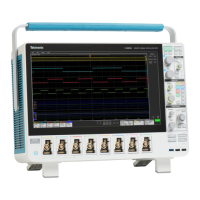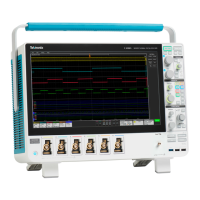Command groups
The defined bina
ry formats specify the order in which the bytes are transferred.
The following are the four binary formats:
RIBinary spec
ifies signed integer data-point representation with the most
significant byte transferred first.
SRIBinary i
s the same as RIBinary except that the byte order is swapped,
meaning that the least significant byte is transferred first. This format is useful
when transferring data to PCs.
RFBinary specifies floating point data-point representation with the most
significant byte transferred first.
SRFBinary is the same as RFBinary except that the byte order is swa pped,
meaning that the least significant byte is transferred first. This format is useful
when transferring data to PCs.
Waveform data and record lengths. You can transfer multiple points for each
wavefo
rm record. You can transfer a portion of the waveform or you can transfer
the entire record. You can use the
DATa:STARt and DATa:STOP commands to
specify the first and last data points of the waveform record.
When transferring data from t he instrument, you must specify the first and last
data points in the waveform record. Setting
DATa:STARt to1andDATa:STOP to
the record length will always return the entire waveform.
Waveform data locations and memory allocation. The DATa:SOUrce command
spe
cifies the waveform source when transferring a waveform from the instrument.
Waveform preamble. Each waveform that you transfer has an associated
waveform preamble that contains information such as the horizontal scale, the
vertical s cale, and other settings in effect when the waveform was created. Refer
to the individual WFMOutpre? commands for more information.
Scaling waveform data. Once you transfer the waveform data to the controller,
you can convert the data points into voltage values for analysis using information
from the waveform preamble.
MSO54, MSO56, MSO58, MSO58LP Programmer 2-89
